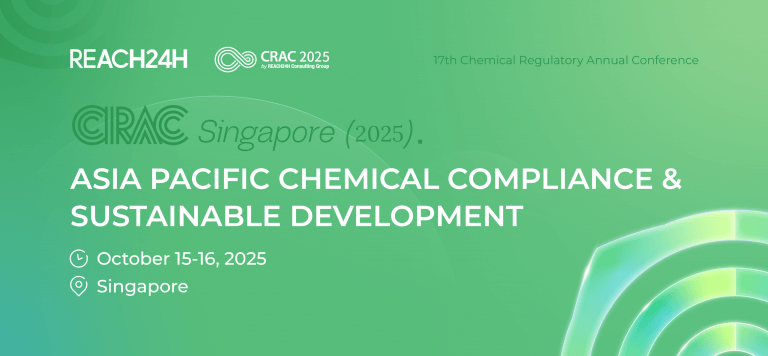As global chemical management requirements become increasingly stringent, the EU Regulation on Registration, Evaluation, Authorisation and Restriction of Chemicals (REACH) imposes higher compliance demands on enterprises.
Under the REACH framework, correctly distinguishing between "articles" and "substances/mixtures" is critical for fulfilling registration, notification, and restriction obligations. However, many products fall into the borderline between articles and substances/mixtures, making classification complex and often confusing for enterprises.
To help enterprises better address this challenge, the European Chemicals Agency (ECHA) released the fourth edition of the Guidance on the Borderline between Substances/Mixtures and Articles (hereinafter referred to as the "Guidance") in May 2025. This Comprehensive Guide to Article Identification provides clear guidance for the industry.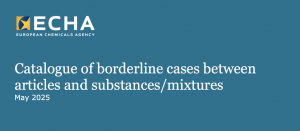
What Are Articles and Substances/Mixtures Under REACH?
Under REACH, an "article" is defined as an object which, during production, is given a specific shape, surface, or design that determines its function to a greater degree than does its chemical composition. For example, a drill bit is classified as an article because its spiral shape and cutting edges enable its drilling function. A "substance" means a chemical element and its compounds in the natural state or obtained by any manufacturing process, including any additive necessary to preserve its stability and any impurity deriving from the process used, but excluding any solvent which may be separated without affecting the stability of the substance or changing its composition. A "mixture" means a mixture or solution composed of two or more substances. In summary, the chemical composition of substances/mixtures primarily determines their function, whereas the shape, surface, or design of articles has a greater impact on their function than their chemical composition. For borderline cases, such as complex products containing substances (e.g., lighters, reusable hot and cold packs), the components must be evaluated separately.
Three-Step Identification Method for Product Type Determination
To help enterprises accurately determine product types, ECHA has proposed a "Three-Step Identification Method":Step 1: Determining the Core Function—What is the primary purpose of the product? Identifying the primary function of the product is the first step in determining its type. For example, the primary purpose of a drill bit is drilling, while the primary purpose of a water-soluble plastic bag is to contain and release its contents.Step 2: Priority of Shape and Design—For the function identified in Step 1, is the shape/surface/design more important than the chemical composition? For a drill bit, its spiral shape and cutting edges are critical to its drilling function, while the chemical composition only affects its durability. Therefore, the shape and design are more important than the chemical composition. For a water-soluble plastic bag, its specific dissolvable design enables it to contain and release its contents, so it is also classified as an article.Step 3: Possibility of Separation—Can the substances contained in the product be separated? For a water-soluble plastic bag containing contents (e.g., laundry detergent pods), the bag itself is regarded as an article as per Step 2, but the contents (detergent) are separable and thus regarded as a substance/mixture. The entire product is therefore a combination of an article and a substance/mixture. By analyzing the importance of function, shape, and chemical composition, as well as the separability of substances, enterprises can accurately determine product types using the above three steps.
Typical Cases of Articles and Substances/Mixtures
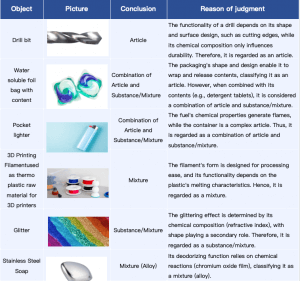
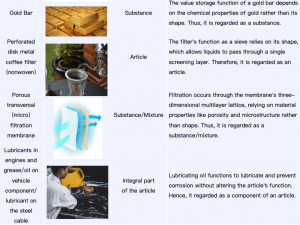
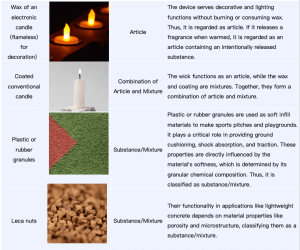
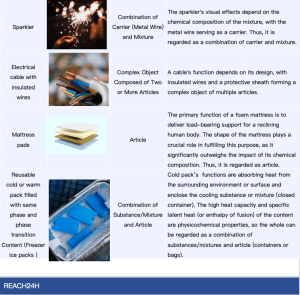
Why Correctly Distinguishing Articles and Substances/Mixtures Matters
Correctly distinguishing between articles and substances/mixtures directly impacts subsequent compliance obligations for enterprises:Articles: If they contain more than 0.1% (w/w) of Substances of Very High Concern (SVHC), notification and information communication obligations must be fulfilled. If the tonnage exceeds 1t/y, SVHC submission is also required. If the article contains substances released intentionally, registration obligations must also be fulfilled.Substances/Mixtures: These require REACH registration or compliance with specific restriction requirements.Combination Products: The article and substance/mixture components must be evaluated separately for compliance. For example, the fuel in a lighter is managed as a substance/mixture, while the container is managed as an article.
Measures for EU Exporting Enterprises
The "Guidance" published by ECHA provides a key tool to help enterprises resolve the challenges of determining articles and substances/mixtures under REACH. Through clear case studies and scientific evaluation methods, enterprises can confidently address compliance challenges and ensure the legal circulation of their products in the EU market. However, with advancements in technology and increasing product diversification, the complexity of borderline cases will continue to increase. Enterprises must remain vigilant and update their strategies for regulatory compliance in response to the evolving regulatory environment. REACH24H reminds EU exporting enterprises:Familiarize with Guidance Documents: Enterprises should refer to ECHA's Guidance on Requirements for Substances in Articles and the "Guidance" to understand evaluation processes and cases, ensuring a clear understanding of specific regulatory requirements.Comparison with Case Studies: Compare products with cases in the Guidance, analyzing the importance of function, shape, and chemical composition. For example, products similar to lighters (e.g., camping gas stoves) can be classified using the same logic.Seek Professional Assistance: For complex cases, enterprises can seek help from professional consulting agencies or ECHA to avoid the risk of non-compliance.




